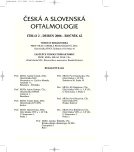The Influence of IOL Implantation on Visual Acuity, Contrast Sensitivity and Colour Vision 2 and 4 Months after Cataract Surgery
Authors:
J. Ventruba
Authors‘ workplace:
Klinika nemocí očních a optometrie FN u sv. Anny a LF MU, Brno
přednosta doc. MUDr. Svatopluk Synek, CSc.
Published in:
Čes. a slov. Oftal., 62, 2006, No. 2, p. 133-143
Overview
Purpose:
To assess the change in visual acuity, contrast sensitivity and colour vision in relation to the time after cataract surgery and to the type of implanted IOL, and to compare visual functions by patients with one and two pseudophakic eyes.
Methods:
45 cataract patients were examined before and then 2 and 4 month after the cataract surgery. Visual acuity (VA) was tested on logMAR optotype chart with Landolt rings, contrast sensitivity (CS) was tested on the Pelli- Robson chart and the SWCT chart. For colour vision (CV) testing, the standard Farnsworth D-15 test and the desaturated Lanthony D-15 test were used. The patients were divided into two groups – a group with one pseudophakic eye and a group with two pseudophakic eyes, and also according to the type of IOL – PMMA or hydrophobic acrylate that had been implanted. Control group was composed of phakic subjects with no ocular pathology.
Results:
After the cataract surgery, in both groups there was a significant improvement in monocular and binocular VA (p < 0.05), in monocular and binocular CS using both types of charts – Pelli-Robson (p < 0.05) and SWCT in all the spatial frequencies (p < 0.05). Also, a significant decrease in the number of minor errors in the standard Farnsworth D-15 test (p < 0.05) as well as a substantial decrease in the number of minor and major errors in the desaturated Lanthony D-15 test (p < 0.05) and an overall improvement of CV (p < 0.05) were detected. There was no difference between the results 2 and 4 month after the surgery, except for CS in 12 c/deg (p < 0.05). The patients with two pseudophakic eyes had postoperatively better binocular VA and CS in the spatial frequencies of 12 c/deg and 18 c/deg and attained postoperative values comparable to those of control subjects. No significant difference in VA, CS or CV was found between the PMMA and hydrophobic acrylate intraocular lenses.
Conclusion:
After the cataract surgery, the visual functions tested by means of psychophysical methods of VA, CS and CV significantly improve and are stable 2 month after the surgery. The second eye surgery improves binocular visual functions the level of which doesn’t differ from that of normal phakic subjects. There was no influence of the type of IOL on final state of VA, CS or CV.
Key words:
visual acuity, contrast sensitivity, colour vision, type of IOL, second eye surgery
Labels
OphthalmologyArticle was published in
Czech and Slovak Ophthalmology

2006 Issue 2
Most read in this issue
- Vernal Keratoconjunctivitis and Possibilities its Treatment
- The Orbital Implant after Exenteration of the Orbit with the Preservation of the Eyelids and the Conjunctival Sac
- The Influence of IOL Implantation on Visual Acuity, Contrast Sensitivity and Colour Vision 2 and 4 Months after Cataract Surgery
- Bilateral Retinal Vasculitis with Arterial Aneurysms
